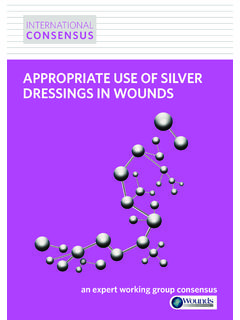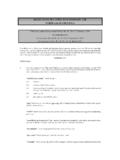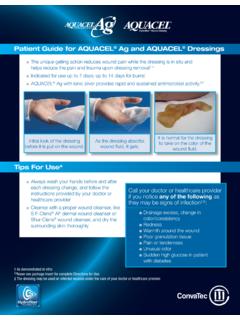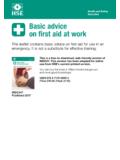Transcription of Offshore COSHH essentials - Health and Safety …
1 Health and Safety ExecutiveCleaning up body fluids Control approach 1 General ventilationOCEO ffshore COSHH essentialsThis information will help Offshore dutyholders (owners, operators and contractors) to comply with the Control of Substances Hazardous to Health Regulations 2002 ( COSHH ), as amended, to protect workers guidance consolidates good control practice and reinforces existing knowledge with additional will help you carry out COSHH assessments, review existing assessments, deliver training and in supervising activities involving substances hazardous to is aimed at staff whose responsibilities include the management of substances hazardous to Health on Offshore installations (eg occupational Health specialists, COSHH assessors, supervisors etc). It is also useful for trade union and employee Safety this guidance is not compulsory and you are free to take other action.
2 But if you do follow this guidance, you will normally be doing enough to comply with the law. Health and Safety inspectors seek to secure compliance with the law and may refer to this guidance as illustrating good see essential information on the back of the this sheet covers This sheet describes good practice for clearing up body fluids vomit, faeces, blood etc. It covers the key points you need to follow to help reduce exposure to an acceptable level, as part of your COSHH Body fluids are a source of infectious micro-organisms (bacteria, viruses and fungi).3 The main risk is infection following hand to mouth/nose/eye There is also a risk of infection via broken skin (cuts or scratches).3 Cleaning products may contain hazardous substances such as biocides and Health effects from cleaning products include irritation, dermatitis and breathing Erect barriers and Store cleaning products and materials in a designated and proceduresControl equipment3 Provide dedicated cleaning Chlorine-releasing disinfectant is suitable, eg hypochlorite Provide closeable containers and bags, labelled Clinical waste.
3 3 Provide buckets with disinfectant and long-handled brushes for personal decontamination at the exit procedures3 Ensure a good standard of general Scrape up residues into the closeable container, for safe Bag up contaminated material that needs laundry or disposal, eg bedding, Wash surfaces clean with detergent before Heavily fouled soft furnishings may need bagging for disposal as clinical up body fluids OCE23 General ventilationFirst aid3 Provide sterile wipes and clean water to cleanse Keep a supply of sterile adhesive waterproof dressings protective equipment (PPE) see OCM33 Respiratory protective equipment (RPE) is not protective equipment3 Provide eye protection a full-face Provide disposable coveralls with a Provide a disposable plastic Provide wellingtons or waterproof disposable Provide waterproof, abrasion-resistant gloves, eg Ensure that all cuts and abrasions are covered with a waterproof dressing before work and housekeepingDecontamination3 Assume that everything that might be contacted by body fluids is Clean and disinfect the area after the Use the buddy system to decontaminate PPE and work clothing minimise the spread of Change out of work clothing before exiting the Provide bags labelled Clinical waste Biohazard for all contaminated Disinfect or sterilise reusable work Ensure that waste from the cleaning of body fluids is disposed of safely according to local rules and.
4 If soiled, bag up work clothes for laundry as a separate load. Personal decontamination and skin care3 Wash before eating or drinking, and after touching any surface or object that might be Provide warm water, mild skin cleansers, nailbrushes, and soft paper, fabric towels or hot air for drying. Avoid abrasive Instruct workers in how to clean their skin Provide pre-work skin creams, which will make it easier to wash dirt from the skin, and after-work creams to replace skin : Barrier creams or liquid gloves do not provide a full surveillance3 Conduct skin checks for Keep good records of gastric upsets monitor that personal hygiene is Where appropriate, make available effective vaccines for those workers at risk of repeated exposure to body up body fluids OCE23 General ventilationPublished by the Health and Safety Executive 03/11 Crown copyright 2011 This guidance was developed by representatives from the UK Offshore oil and gas industry and trade unions, with and supervision3 Provide supervision ensure that safe work procedures are Tell workers, including maintenance workers, what the hazards and risks Explain the early signs of Training includes toolbox talks on:n how to use the right safe working procedures;n checking for damage;n personal hygiene.
5 N how to decontaminate effectively; andn what to do if something goes Involve managers and supervisors in Health and Safety information OCE0 Advice for managers OCM3 Personal protective equipment (PPE) OCE22 Cleaning accommodation and facilitiesEmployee checklist Are you clear about the procedures for doing the job? Clean up leaks and spills immediately. Look for signs of wear and damage to equipment. If you find any problem, get it fixed. Don t just carry on working. Report all illnesses to your supervisor. Use, look after and store your PPE in accordance with instructions. Wash hands before eating, drinking or using the informationWorking with sewage: Thehealth hazards A guidefor employees Pocket cardINDG197 HSE Books can find the full OffshoreCOSHH essentials series

















